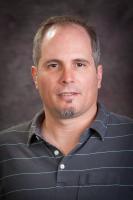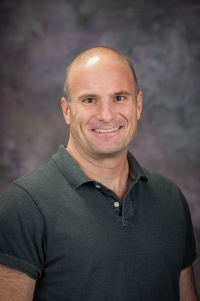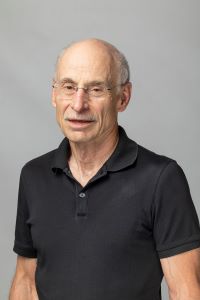NSF REU at K-State: Interactions of Matter, Light and Learning
The K-State REU program offers summer fellowships to do world-class research in our friendly physics department in the scenic Flinthills. We are funded by the National Science Foundation.
Condensed Matter (CM) or Soft Matter Physics
 Dr. Bret Flanders: Living cells, driven far from equilibrium
Dr. Bret Flanders: Living cells, driven far from equilibrium
Email: bret.flanders@phys.ksu.edu
The laws of thermodynamics are exact when systems are in complete equilibrium. Not only is it often hard to know if a sample being observed in a lab is truly in equilibrium, it is even harder to know how to proceed when a system is definitely not in equilibrium. This question lies in the realm of non-equilibrium statistical mechanics. Living biological cells present a fascinating opportunity to investigate systems far from equilibrium because living cells are essentiallynever in thermal, chemical, or mechanical equilibrium. The best that can be said is that an inactive cell may approach a steady-state in which the cell exhibits a (roughly) constant level of ATP consumption. However, some of the most important tasks that cells undergo (e.g. ion pumping to maintain the cellular membrane potential) require rare but important protein configurations and behaviors in order to occur. How does a cell accomplish these rare events, and how does the cell relax back to its steady-state once the task is complete? Nobody knows how to apply non-equilibrium statistical mechanics in a general way to answer these (and many other related) questions. Therefore, the goal of this project is to design and produce nanoscale tools that will permit these questions to be investigated experimentally. Our general approach will be to modulate on sub-second time-scales the membrane potential of individual D. discoideum cells. Doing so will control the open-or-shut state of voltage-gated ion channels as well as the on-or-off activity of ion pumps in the cellular membrane and, thus, provide a method to push the cell far from its steady-state of constant ATP consumption. By holding cells in a far-from-equilibrium state in a controlled manner, we will take an important step towards identifying the molecular components that are utilized in this state; how these components are activated when the state is initiated, and how these components participate in the relaxation of the cell back to its steady-state.
 Dr. Jeremy Schmit: Understanding Protein Self-assembly through simplified models
Dr. Jeremy Schmit: Understanding Protein Self-assembly through simplified models
Email: schmit@phys.ksu.edu
Numerous diseases, including Alzheimer's and prion diseases, are caused by proteins that self-assemble into one dimensional filaments. These filaments are very highly ordered, but it is not known how incoming molecules ultimately select the ordered state from a large ensemble of disordered state. In this project, we will run numerical simulations on a greatly simplified 2-state model representing the ordered and disordered states. The goal will be to determine how factors like the binding energy and protein concentration affect growth rates and the "quality" of the resulting assembly.

Dr. Chris Sorensen: Suspensions as Solutions: Solubility of Nanoparticles
Email: sor@phys.ksu.edu
We have developed chemical methods to make nanoparticles with very uniform size. We have discovered that because of this size uniformity suspensions of these nanoparticles can act like solutions with thermally reversible, temperature dependent solubility. We have published one study [1] for ca. 5.0 nm gold nanoparticles to determine their solubility as a function of their ligand shell and the solvent. The ligands were octane-, decane-, dodecane- and hexadecanethiols; the solvents were the n-alkanes from hexane to hexadecane and toluene. We want to extend these studies to the temperature dependence. We have some preliminary data with an apparatus that we have built. We need to continue this work to obtain a good set of systematic data. With analysis, these data will lead to a measure of the interparticle potential.
1. “Solubility of Gold Nanoparticles as a Function of Ligand Shell and Alkane Solvent”, B. C. Lohman, J. A. Powell, S. Cingarapu, C. B. Aakeroy, A. Chakrabarti, K. J. Klabunde, B. M. Law, and C. M. Sorensen, Phys. Chem. Chem. Phys., 14, 6502- 6506 (2012).